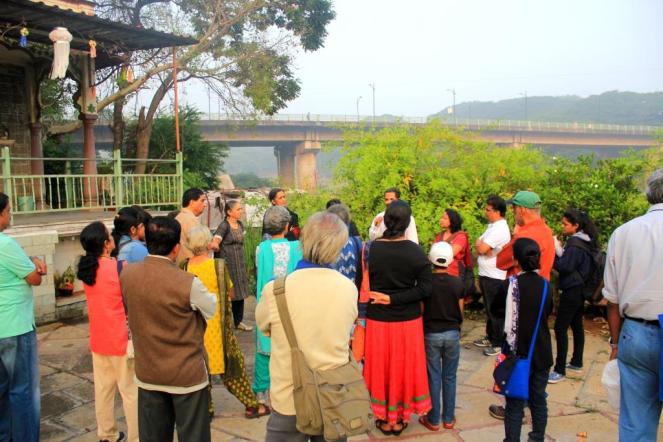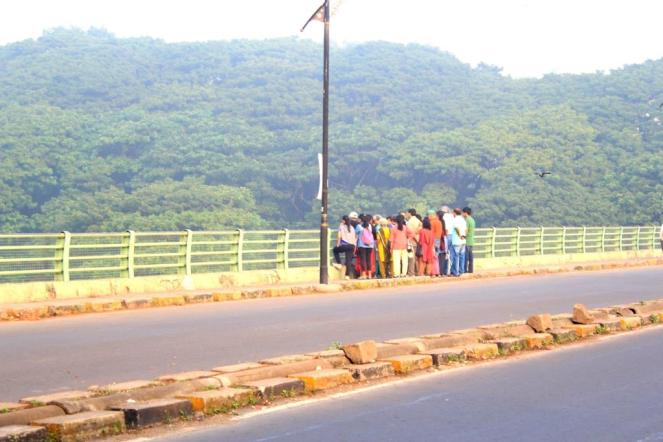“A River Walk in Pune City? You must be kidding!” said my old friend when I asked her to join me for the Muthai River Walk on the India Rivers Day. I could not blame her. Inside the city limits, Pune’s Rivers: Mula, Mutha, Pawana, Indrayani and smaller rivulets like Dev Nadi and Ram Nadi look anything but walk-worthy. We Punekars have ensured that our rivers stink, are clogged with sewage and solid waste, have little water and carry exclusive sewage. Even the seasoned Jairam Ramesh, when he visited Pune as the Union Environment Minister, was appalled at the state of Mula-Mutha. He immediately wrote a strong-worded letter to the Collector, but that did not really change anything.
According to the State Pollution Control Board, Pune District has maximum number of polluted river stretches in the state. On an average, less than 50% generated sewage is treated in the Sewage Treatment Plants. Although the Krishna Water Disputes Tribunal Award has directed the State to release 60 cubic feet per second (cusecs) of water as Environmental Flows, we do not do it. Pune has been building roads inside its riverbed, constricting the river channel and dumping construction waste haphazardly inside the river. In other words, like any Indian City, Pune City does not show any concern for its Rivers: Mula and Mutha.
This was one of the reasons why I was interested in attending the Muthai River Walk organised by Jeevit Nadi, Virasat (Janwani Project)and Ecological Society. What made the walk special was the fact that it was organised to celebrate India Rivers Day.

On the 28th November, we assembled at 7 am on the Siddheshwar Ghats along the Mutha, in the heart of old Pune city. An enthusiastic team welcomed all those who had gathered here: some 20-25 Punekars in the age group of 8 to 75 years! The river was veiled under a blanket of fog was looking beautiful.
Aditi Deodhar and Manish Ghorpade who have been working very hard for Pune’s Rivers through the Jeevit Nadi Initiative, introduced the group to Mutha and shared an interesting story about the myth behind Mula and Mutha. In a nutshell, Mula and Mutha were Apsaras, sent from the heavens to distract a Rishi on penance, who cursed the them to turn into rivers. (With growing pollution, encroachment and no flows, Punekars seem to be taking the curse part very seriously)
After sharing interesting tidbits about the archaeological setting of the river and showing us fascinating pictures, the guides introduced us to existing flora and fauna of the river, which now mainly consists of hardy species like Alternanthera, Parthenium and scavengers like Pariah Kites. They also showed pictures of the ancient Mutha Ghats and bird species found when the water was relatively clean, like the River Tern and Pheasant-tailed Jacana.
Aditi pointed towards a retaining wall of an old structure along the river bank: the wall was way behind the road that Pune Municipal Corporation (PMC) has built, inside the river bed and where we were standing. Hundreds of years ago, river’s space was respected and the only punctuation marks along the banks were small temples and monuments.
We could see a number of sewage outfalls bringing sewage directly into the river as well as sewage pipeline laid inside the riverbed leaking into the river. For this reason, we have been protesting laying of sewage pipes inside the river channel…but PMC does not seem to be bothered.

The group went around an old Samadhi of Appasaheb Patwardhan, Lokmanya Tilak’s Guru and was told about the 18th Century water supply system thats exists till date in Pune, bringing water from Katraj Lakes, to the heart of the city through underground channels. The system is neglected and in shambles now, but still brings clear water to the river. This is remarkable, when bring only filth to the river toay and we cannot even set up a closed pipe water supply from Khadakwasla Dam to the city!
We climbed up from the river bed, using a cool stone staircase, supposedly also used by Rani Laxmibai when she came to Pune and wanted to come down to the river.
Up on the Omkareshwar Bridge, we could see the beautiful but ravaged Mutha glimmering in the morning sun. After some unique details about the river and her ancient connection with the city, Aditi and Manish told us about the pollutants we release in the river. Aditi emphatically said that every citizen should make a beginning from herself for the river. One step is to limit the amount of cleaning chemicals (like Floor cleaners) we use in the house. Ecological Society and Jeevit Nadi support and help citizens in selecting natural cleaning agents. Thanks to them, I have been using Vinegar and Baking Soda for most of my household cleaning needs. They work just fine.
 As we concluded our walk, Manish asked, “So Why should we protect Mutha? Why should we protect our rivers?
As we concluded our walk, Manish asked, “So Why should we protect Mutha? Why should we protect our rivers?
“Because our bodies are 70% water..and this water is from our rivers. We ARE our rivers.”
We need to protect the rivers to protect ourselves and our children. My 8 year old son who had come along for the walk (trifle unhappily) grasped this before I could, looked up to me and smiled.
We have heard of river walks along beautiful rivers in Chicago or the San Antonia River Walk, or the Singapore Riverfront walk. But Muthai River Walk, which tries to connect us with our heritage, is special. Bringing us close to a Living River (dying at places) without any frills, it showed us what was and what could be. That such an urban initiative is taken up by enthusiastic citizens in our country is so very rare and hence, commendable. This was the perfect way for me to celebrate the India Rivers Day.
I hope more people of Pune attend Muthai River Walk to explore the known and unknown aspects of our lifelines. JeevitNadi, Virasat (Part of Janwani) and Ecological Society conduct Muthai River walk every Sunday Morning. Contact Details: https://www.facebook.com/events/1653110311637394/, https://jeevitnadi.wordpress.com/muthai-2/
As we went our ways, my son saw that bridge where we were standing, was festooned with tiny, black ribbons..this was the very bridge where Narendra Dabholkar: rationalist and leader of the anti-superstition movement in Maharashtra was brutally killed in August 2013. The ribbons were a form of silent protest, tied by thousands of Dabholkar’s supporters. As we looked at the clogged and chocked river below through the black, silent ribbons, it seemed as if they were a part of the River’s protest against us too.
Parineeta Dandekar, parineeta.dandekar@gmail.com
POST SCRIPT: A report about this River walk in Pune on India Rivers Day, from the organisers of the walk can be seen here: http://www.virasatpune.com/commemorating-india-rivers-day/ and photos of the walk can be seen here: https://www.facebook.com/MuthaiRiverWalk/posts/553440611474742.


Frds,
“A smart city is not just good traffic management but it’s where all such aspects of life’s daily needs too are taken care! Here one will wonder where the real estate is concerned with above issues, well if all such points are taken care, in & around the city then only affordable home’s dream is going to be possible”…
City’s infra works, who should govern them? My views about the same, you can read it at link below & do share if liked..
http://visonoflife.blogspot.in/2016/03/pmc-goes-private.html
sanjay deshpande
LikeLike
nice factual analysis of pune’s rivers
LikeLike